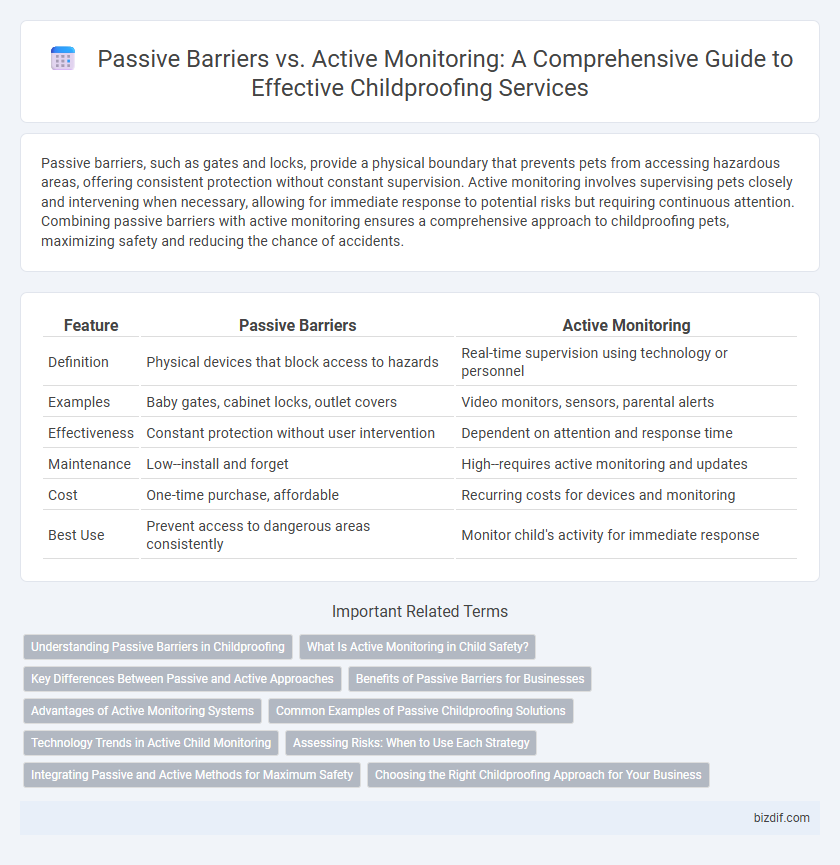Passive barriers, such as gates and locks, provide a physical boundary that prevents pets from accessing hazardous areas, offering consistent protection without constant supervision. Active monitoring involves supervising pets closely and intervening when necessary, allowing for immediate response to potential risks but requiring continuous attention. Combining passive barriers with active monitoring ensures a comprehensive approach to childproofing pets, maximizing safety and reducing the chance of accidents.
Table of Comparison
| Feature | Passive Barriers | Active Monitoring |
|---|---|---|
| Definition | Physical devices that block access to hazards | Real-time supervision using technology or personnel |
| Examples | Baby gates, cabinet locks, outlet covers | Video monitors, sensors, parental alerts |
| Effectiveness | Constant protection without user intervention | Dependent on attention and response time |
| Maintenance | Low--install and forget | High--requires active monitoring and updates |
| Cost | One-time purchase, affordable | Recurring costs for devices and monitoring |
| Best Use | Prevent access to dangerous areas consistently | Monitor child's activity for immediate response |
Understanding Passive Barriers in Childproofing
Passive barriers in childproofing provide a physical obstacle that prevents children from accessing hazardous areas, such as safety gates or cabinet locks, ensuring continuous protection without requiring active parental intervention. These barriers are designed to function independently, reducing reliance on constant supervision and minimizing the risk of accidents in environments like kitchens, staircases, and bathrooms. Implementing effective passive barriers enhances home safety by creating secure zones that restrict access to potential dangers during everyday activities.
What Is Active Monitoring in Child Safety?
Active monitoring in child safety involves constant supervision and real-time response to potential hazards, using tools like video cameras, motion sensors, and alert systems to ensure immediate intervention. Unlike passive barriers such as safety gates and cabinet locks that physically restrict access, active monitoring provides dynamic oversight and allows caregivers to promptly address situations as they arise. This approach enhances childproofing by combining technology and human vigilance to prevent accidents effectively.
Key Differences Between Passive and Active Approaches
Passive barriers such as safety gates and cabinet locks physically restrict access to hazardous areas, providing a constant and reliable layer of protection without requiring ongoing supervision. Active monitoring involves real-time observation and intervention through devices like baby monitors and motion sensors, offering immediate response capabilities but depending on caregiver attentiveness. The key difference lies in passive barriers offering continuous, maintenance-free safety measures, while active monitoring requires vigilant engagement for effective childproofing.
Benefits of Passive Barriers for Businesses
Passive barriers provide businesses with continuous, maintenance-free protection by physically restricting access to hazardous areas, significantly reducing liability risks and accident rates. Unlike active monitoring systems that require constant supervision and human intervention, passive barriers offer a reliable, cost-effective solution to childproof environments without increasing labor expenses. These barriers enhance safety compliance while allowing staff to focus on core operations, improving overall efficiency and customer trust.
Advantages of Active Monitoring Systems
Active monitoring systems offer real-time alerts and continuous surveillance, significantly reducing the risk of accidents in childproofing environments. Unlike passive barriers that physically restrict access, these systems enable proactive response to potential hazards, enhancing overall safety and parental peace of mind. Integration with smart home devices further optimizes protection by allowing remote supervision and immediate intervention.
Common Examples of Passive Childproofing Solutions
Common examples of passive childproofing solutions include safety gates, cabinet locks, outlet covers, and corner cushions, which create physical barriers preventing child access to hazardous areas. These passive barriers require no active supervision to function, offering continuous protection by design. In contrast, active monitoring relies on caregiver vigilance and responsive actions to ensure child safety.
Technology Trends in Active Child Monitoring
Active child monitoring technology integrates real-time sensors, wearable devices, and AI-driven alerts to enhance safety beyond traditional passive barriers like gates and locks. Innovations such as GPS tracking, motion detection, and smart home connectivity enable parents to receive instant notifications about a child's location and activity patterns. These advancements significantly reduce risks by providing dynamic supervision that adapts to a child's movements and environment.
Assessing Risks: When to Use Each Strategy
Passive barriers, such as safety gates and cabinet locks, provide constant protection by physically restricting a child's access to hazardous areas, making them essential in high-risk zones like staircases and kitchens. Active monitoring involves supervising the child in real-time, suitable for low-risk areas where immediate intervention can prevent accidents. Assessing risks requires evaluating the environment and the child's behavior to determine when fixed barriers are necessary versus situations that allow for attentive supervision.
Integrating Passive and Active Methods for Maximum Safety
Integrating passive barriers such as safety gates and cabinet locks with active monitoring devices like baby monitors and wearable alerts ensures comprehensive childproofing. Passive methods provide constant physical protection by restricting access to hazardous areas, while active monitoring offers real-time supervision and immediate response capabilities. Combining these approaches maximizes safety by preventing accidents and allowing caregivers to promptly address potential dangers.
Choosing the Right Childproofing Approach for Your Business
Passive barriers such as safety gates and cabinet locks provide constant physical protection, preventing accidents without requiring continuous supervision. Active monitoring systems, including video surveillance and alert devices, enable real-time oversight and immediate responses to potential hazards. Selecting the right childproofing approach involves assessing your business environment, traffic flow, and staffing to balance preventative measures with proactive safety management.
Passive barriers vs Active monitoring Infographic

 bizdif.com
bizdif.com